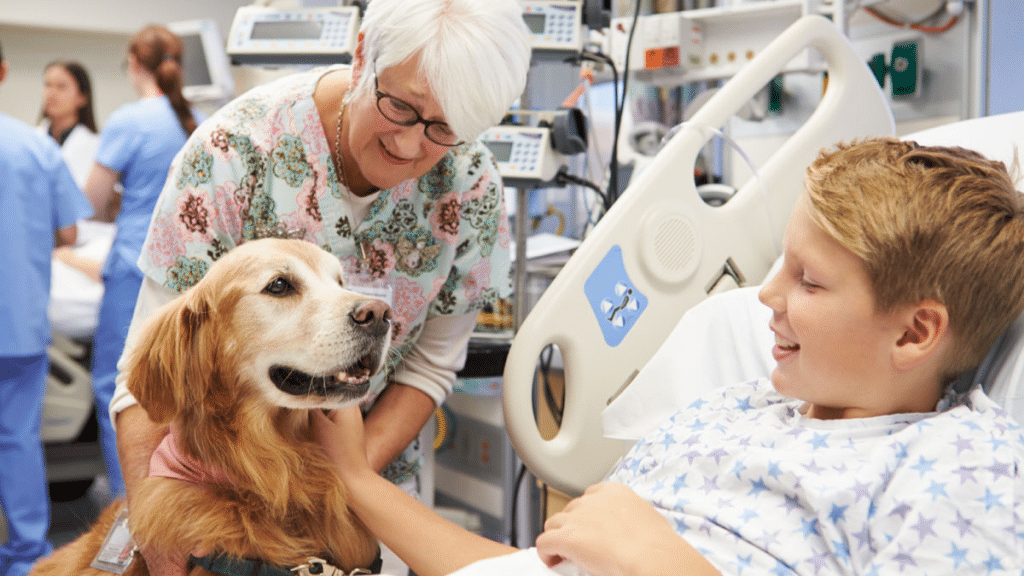The healing power of animal interaction is not new. Even in ancient Egypt, animals were believed to provide spiritual and health protection. This is why the ancient Egyptians held cats in such high esteem, specifically worshipping them and mummifying them after their deaths, as they did human deceased. However, the soothing and pleasurable effect of animals was not then considered a therapeutic treatment.
In 1792, animals were first used for therapeutic purposes, or at least the first records of such use date from that time. William Tuke, an English quaker, was the first to introduce therapeutic animals and they were used in the psychiatric institute he founded.
Here mental patients were treated and the inmates were allowed to interact with animals. The animals, mostly rabbits and various birds, calmed people with mental health problems and helped to keep their behaviour stable.
The roots of animal-assisted therapy, or AAT for short, as we know it today date back to the 1960s, when American child psychologist Dr Boris Levinson observed that his autistic patients became more open when his dog Jingles was present in therapy sessions. Subsequently, the psychologist conducted a series of scientific studies and launched the professional development of animal therapy.
In Which Therapeutic Activities is Animal Therapy most Commonly Used?
Animal therapy is now used in a wide range of medical treatments and activities, as over the years it has made huge breakthroughs in the treatment of diseases where other methods have been less successful.
Psychiatric and Mental Health Treatments
Animal therapy has made positive progress in the treatment of many psychiatric conditions that have caused minor or more severe difficulties in the daily lives of patients. These include depression, anxiety and post-traumatic stress disorder. While a healthy person can reduce stress by visiting Österreichische Online Casinos, others may need special treatment.
Animal therapy has been used in the treatment of autism spectrum disorder and has shown extraordinary results, especially in children. Also, for psychosocial rehabilitation, such as schizophrenia, the presence of an animal can provide relief and peace of mind. In addition, the treatment of emotional and behavioural disorders in children and young adults is significantly facilitated when a therapy animal is involved.
Help in the Treatment of Elderly Patients
Professionally trained therapy animals can be of great help in various geriatric care, such as Alzheimer’s disease or dementia. In relieving the symptoms of these illnesses, canine or horse therapy can improve the patient’s mood, reduce feelings of confusion and increase a sense of security.
A range of therapy animals can also be used to alleviate feelings of loneliness and isolation. This is why we see therapy animals being brought into nursing homes as part of various support programmes, bringing immense joy to the residents and colour to often monotonous everyday lives, as is the case with Österreichische Online Casinos.
Therapeutic Animals in Paediatrics
The treatment of developmental disorders in children is of great importance, especially in the very early stages of life. The sooner the right treatment and therapy is started for the patient, the better and faster the recovery or relief of symptoms. Therapy animals can also be of great benefit in the treatment of autism, attention deficit or movement problems.
Meeting animals can also be a good way to ease long hospital stays, as it has been shown to reduce stress, fear and even pain. Therapy animals can also help with learning difficulties and communication disorders by giving children a sense of security.
Rehabilitation and Physiotherapy Assistance
Horse therapy can be a great help in locomotor rehabilitation, as it helps to improve balance, coordination and muscle tone, so that patients can regain their freedom of movement much sooner.
In the case of post-stroke recovery or even Parkinson’s disease, therapy animals can be of great help, both in terms of movement coordination and motivating patients. Österreichische Online Casino can also be a good motivation, but they are by no means professional help.
Treating Different Types of Addiction
Interaction with therapy animals can help patients treat a wide variety of addictions. Animals can also help build self-confidence, regain emotional stability and manage the stress associated with recovery.
Education and Special Learning
Animal-assisted learning can make a big difference, for example, for children with reading difficulties who prefer to practise and learn when they can read to a dog. In many cases, therapy animals are used in special educational settings to help children learn.
Last but not least, children develop empathy and a sense of responsibility when they interact with therapy animals.
